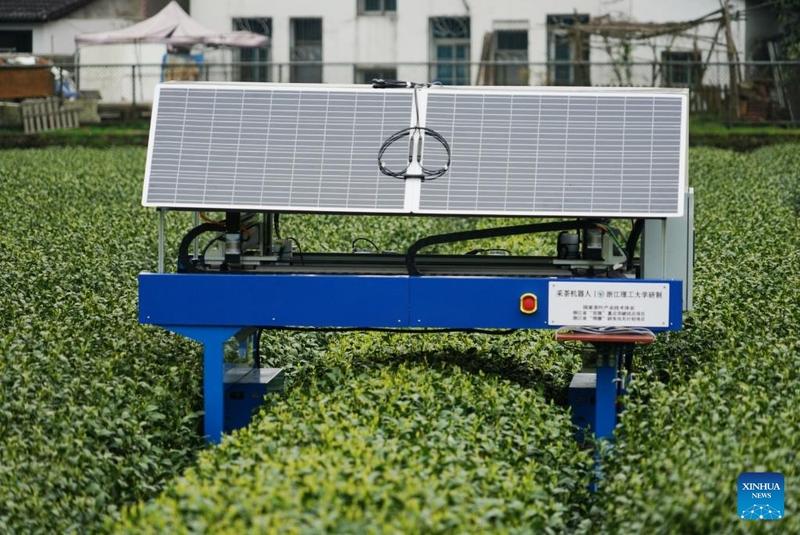 A robot picks tea using binocular stereo vision at a tea garden in Hangzhou, capital of east China's Zhejiang province, March 29, 2023. (PHOTO / XINHUA)
A robot picks tea using binocular stereo vision at a tea garden in Hangzhou, capital of east China's Zhejiang province, March 29, 2023. (PHOTO / XINHUA)
HANGZHOU — With a sun hat made of solar panels, a robot weaves through rows of bushes covered in leaves of renowned Longjing tea in Hangzhou's West Lake scenic spot, in East-China's Zhejiang province.
Agile manipulators and caterpillar tracks make picking the tea a breeze for the mechanical marvel.
The 550-kilogram robot is a godsend for local tea planters this season. The Qingming Festival, which fell on Wednesday this year, marks the start of the major harvest period for premium spring tea, and the local tea gardens are understaffed.
ALSO READ: China's traditional tea-making enters UNESCO heritage list
Longjing tea, also known as West Lake Dragon Well tea, is a variety of green tea. As one of China's 10 most famous teas, it is characterized by its green color, delicate aroma, mellow taste and beautiful shape.
Using binocular stereo vision, the robot can position where the target bud and leaf are, cut them precisely, and then, suck the leaves into its basket via its negative-pressure pipette
"The beautiful forms of a bud with one leaf or a bud with two leaves are often acknowledged as quality tea. The picking work of such tea leaves has relied largely on manual work, very difficult to be replaced by machinery," says Jia Jiangming, developer of the robot and an associate professor from the school of mechanical engineering of Zhejiang Sci-Tech University.
READ MORE: In the mood for Longjing tea
However, most of the tea pickers in the production areas of Longjing tea are all in their 60s, few are in their 50s, and hardly any young people are keen to take up jobs in the industry.
"If so, the Longjing tea industry may face issues when there is nobody left to help pick the leaves," Jia says when explaining why his team started to develop tea-picking robots as early as 2019.
Generally speaking, one bud and one leaf of the early spring tea is about 2 centimeters long, and the petiole is merely 3 to 5 millimeters long, thus demanding a high operation accuracy of the mechanical arms. If cut at the wrong angle, the robot will damage the tea branch or harvest an incomplete bud and leaf.
The damaged tea leaves can not be used, causing unnecessary waste, according to the researchers.
 This photo taken on March 29, 2023 shows a tea-picking robot working at a tea garden in Hangzhou, capital of east China's Zhejiang province. (PHOTO / XINHUA)
This photo taken on March 29, 2023 shows a tea-picking robot working at a tea garden in Hangzhou, capital of east China's Zhejiang province. (PHOTO / XINHUA)
Jia's team introduced a cognition model of convolutional neural networks and deep learning, enabling the robot to study lots of data and many images of tea tree buds and leaves.
Using binocular stereo vision, the robot can position where the target bud and leaf are, cut them precisely, and then, suck the leaves into its basket via its negative-pressure pipette.
Earlier this year, the fifth generation of Jia's robot helper was brought online, lifting the accuracy of bud and leaf recognition to 86 percent and improving the picking efficiency to 1.5 seconds per tea leaf.
ALSO READ: Preserving the tea heritage
Compared with the third-generation robot, which was launched last year, the upgraded robot's overall tea-picking success rate rose from 40 percent to 60 percent.
"The new generation robot can perform as well as a human tea picker," says Chen Jianneng, another researcher on the team, adding that, although the robot is still in trial operation, the team plans to improve its practicality, thus allowing the tea industry to enjoy tangible benefits brought by mechanization in the near future.


